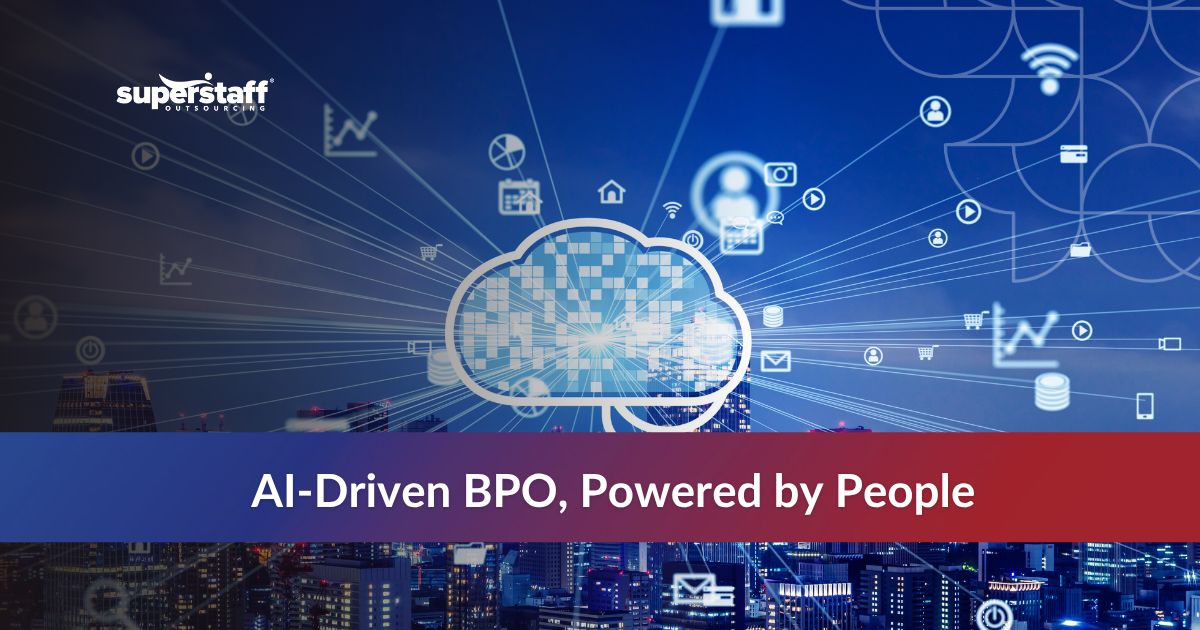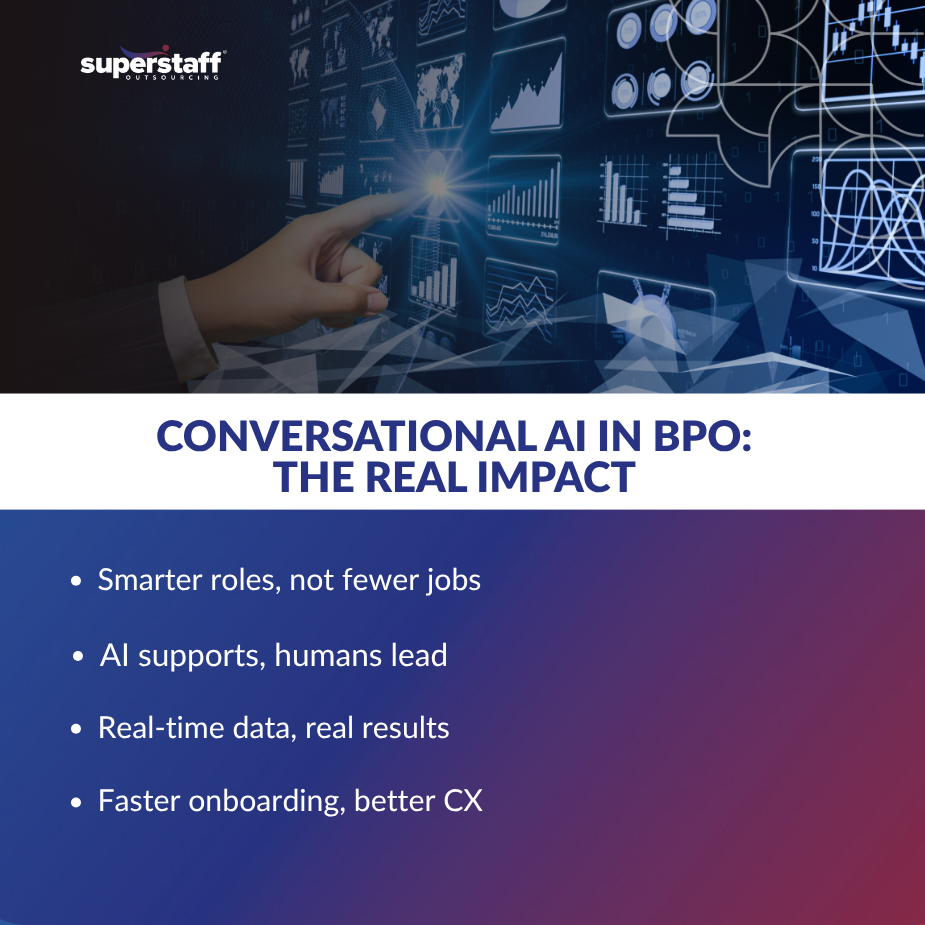
Artificial intelligence isn’t coming for BPO jobs—it’s changing how they’re done.
The rise of conversational AI in BPO operations is not a threat. It’s an opportunity. AI technologies—particularly in customer engagement and data processing—are helping BPOs evolve from being task-driven entities into high-value strategic partners. As the demand for speed, personalization, and scalability grows, business leaders need to know: It’s not about man versus machine. It’s about what’s possible when they work together.
This blog explores how conversational AI in BPO is actively reshaping operations, team structures, and client outcomes. We’ll move past surface-level hype to show real-world transformations happening across the industry. This is a guide for decision-makers who want to leverage BPO not just as a cost center—but as an innovation engine.
Augmenting, Not Replacing: The Real Role of AI in the BPO Workforce

One of the most common misconceptions about AI is that it replaces human jobs. In reality, the opposite is true in modern BPOs. Conversational AI in BPO environments handles the repetitive, rule-based tasks that slow agents down—data entry, transcription, call routing, and basic queries—freeing up human teams to focus on high-value work.
This shift empowers agents to apply human strengths like empathy, judgment, and problem-solving. AI doesn’t eliminate the need for people—it makes their jobs more meaningful and more impactful. It’s a tool that enhances productivity, not a substitute for human connection.
In BPOs that integrate conversational AI in BPO thoughtfully, we’re seeing a rise in engagement and job satisfaction among agents. When people are no longer bogged down by mundane work, they can deliver more thoughtful service and even handle more complex issues that drive real client retention.
This augmentation is redefining workforce planning. Success in 2025 and beyond will come not from cutting headcount, but from restructuring teams to make the best use of both AI and human skills.
A New Breed of Talent: AI-Driven Roles Within BPOs
As conversational AI in BPO becomes more deeply embedded, entirely new roles are emerging. Today’s top-performing BPOs are no longer hiring just call center agents or back-office specialists. They’re building hybrid roles that blend technical fluency with service excellence.
Consider the rise of AI trainers—professionals who teach models how to understand nuanced customer behavior. Data annotation specialists now ensure AI engines have high-quality, labeled data to learn from. Prompt engineers, a role few knew existed five years ago, are helping fine-tune large language models to perform specific client tasks.
Even more critical are human-in-the-loop (HITL) specialists who oversee AI decision-making, providing the necessary check when automation encounters a gray area. These professionals don’t just keep AI ethical—they keep it effective.
To support these new roles, BPOs are reinventing their training systems. AI-assisted learning platforms allow for real-time feedback, skill assessments, and faster onboarding. In the context of conversational AI in BPO, training is no longer just about soft skills. It’s about data literacy, system navigation, and adaptive thinking.
Operational Speed Meets Strategic Agility
Clients want faster service. AI makes it happen. With conversational AI in BPO systems, response times are being cut dramatically—while accuracy continues to improve. That’s not just good service. That’s a competitive advantage.
AI tools like predictive analytics allow teams to anticipate customer needs before they escalate into issues. Agents are supported in real-time by systems that suggest responses, flag sentiment, and even summarize past interactions—saving valuable seconds on every call or chat.
Meanwhile, natural language processing (NLP) ensures customers feel heard and understood, even when initial queries are handled by bots. It’s not just about speed. It’s about intelligent responsiveness.
For example, a client might once have relied on a large team of agents to handle seasonal surges. Now, with conversational AI in BPO streamlining triage and pre-qualification, fewer agents are required—and they’re more focused on complex, revenue-generating tasks. This kind of scalability is a game-changer, especially for SMEs and midmarket companies.
Smarter Customer Experience, Powered by AI
Personalization is no longer a luxury. It’s the baseline. AI enables BPOs to deliver it at scale.
Conversational AI in BPO systems supports real-time analysis of customer data—location, browsing history, tone of voice, previous complaints—and provides agents with the insights they need to personalize their responses.
This isn’t about robots pretending to be human. It’s about giving human agents the tools to connect more meaningfully. AI-powered sentiment analysis can identify frustration early and route interactions to the most experienced agents. Dynamic scripting tools allow for tone-adjusted messaging depending on the customer’s emotional state.
These improvements lead to a more satisfying experience for customers and a more empowered experience for agents. When teams are backed by conversational AI in BPO workflows, they’re not guessing what to say next. They’re equipped to solve, respond, and retain.
The net result? Better NPS scores, increased first-contact resolution, and measurable brand loyalty.
Rethinking BPO Structures with AI Integration
Today’s BPOs don’t look like they did a decade ago. That’s because AI is changing how teams are structured—and scaled.
Blended teams are becoming the norm. A modern service team might include chatbot developers, escalation specialists, QA analysts, and traditional agents—all working with conversational AI in BPO environments that are modular and fluid.
Instead of rigid departments, agile pods are built around workflows or client outcomes. AI supports these teams through automated reporting, KPI tracking, and knowledge management. The result is faster pivots, tighter feedback loops, and better client alignment.
Onboarding, too, has evolved. AI-driven learning management systems help agents ramp up quicker by identifying skill gaps and adjusting training modules in real time. This approach cuts onboarding time and improves long-term performance—especially useful in high-turnover industries.
Still, it’s not just about having AI—it’s about implementing it strategically. Without a strong change management process, AI integration can lead to confusion or burnout. That’s why leading BPOs don’t just install AI tools. They redesign workflows to ensure people and tech operate in sync.
The Responsibility That Comes With Power
With great AI comes great responsibility. BPOs must use AI ethically—not just effectively.
Trust is everything in outsourcing. That’s why responsible use of conversational AI in BPO is now a competitive differentiator. Leading firms are investing in governance frameworks, clear audit trails, and bias mitigation tools. They’re also being transparent with clients and agents about how AI is used and where human oversight comes into play.
Automation without accountability is a recipe for reputational risk. That’s why human-in-the-loop design is critical—not only to ensure quality, but also to uphold fairness and compliance.
Whether dealing with personal customer data or sensitive client IP, transparency is key. BPOs must train staff to understand the limits of AI and know when human judgment must take the lead.
AI can help solve customer problems faster. But only humans can solve them right. And that distinction is what keeps clients coming back.
SuperStaff’s AI-Human Synergy in Action
At SuperStaff, we don’t chase trends—we implement what works.
Our approach to conversational AI in BPO is simple: we use AI where it adds value, and we keep humans where it matters most. Whether it’s using real-time support tools to assist agents, or implementing automation in back-office tasks to free up client bandwidth, our focus is always on enhancing—not replacing—the human experience.
Our agents are supported with tools that reduce burnout, increase precision, and improve decision-making. And our clients benefit from faster output, lower costs, and higher-quality service. But what makes our model different is the balance.
We don’t push tech for tech’s sake. We build processes that blend AI outsourcing with a deep understanding of people. That’s what allows us to scale fast without compromising quality.
As AI matures, so will our strategies. But our commitment remains the same: delivering service that’s not only smarter, but also more human.
The Future of Conversational AI in BPO Is Human-Centered
The rise of conversational AI in BPO isn’t eliminating the workforce—it’s transforming it. AI is giving BPO professionals better tools, clearer insights, and the ability to do their jobs with more impact and purpose.
From hybrid roles and smarter teams to real-time customer insights and ethical automation, the modern BPO is more dynamic and data-driven than ever before. And at every turn, it’s the partnership between people and AI that creates the real value.
At SuperStaff, we believe the future belongs to businesses that embrace this synergy. If you’re ready to scale with AI-powered outsourcing solutions that prioritize quality, speed, and the human touch—partner with SuperStaff. Let’s build the workforce of the future, together.






